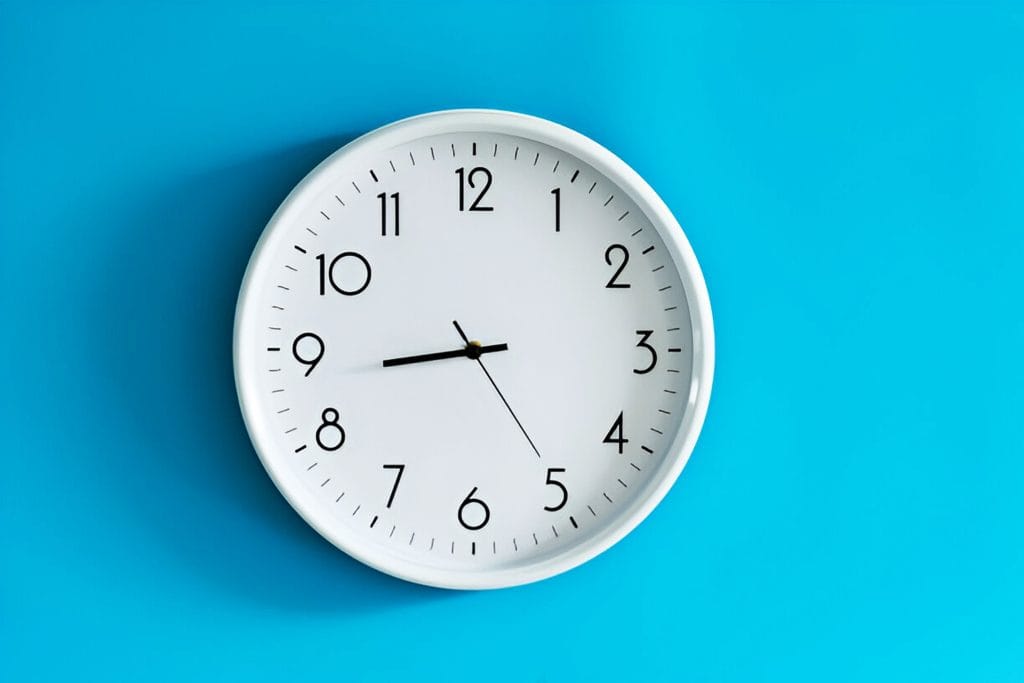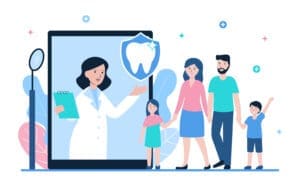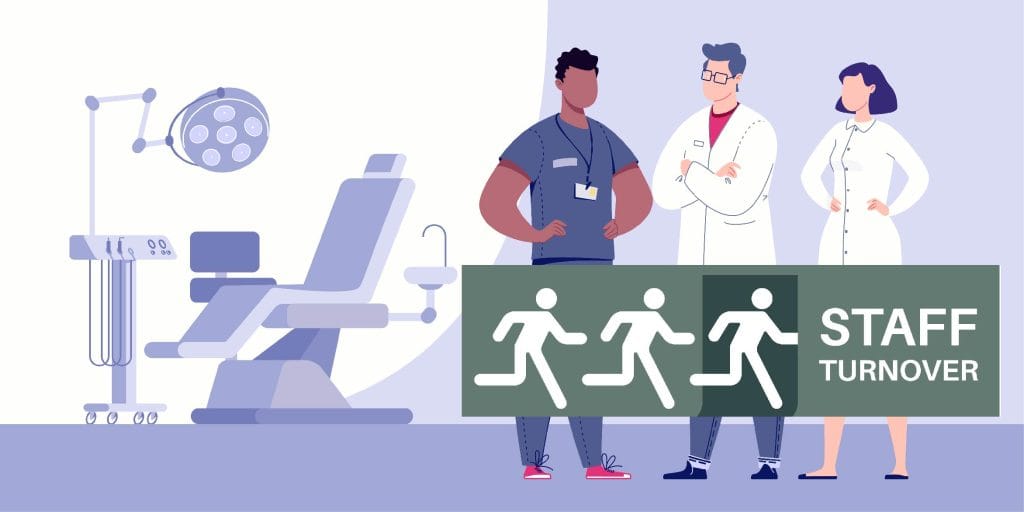
What’s your procedure for scheduling new patient initial exams?
Do you schedule new patient initials with only the doctor? Or are they scheduled in hygiene with the doctor doing the exam at the back end of the appointment? And how long do you schedule these appointments for? An hour? An hour and a half? Two?
If you’ve ever asked yourself these questions, you’re not alone. There’s no real “industry standard” when it comes to new patient initial appointments. Some practices schedule an hour, others an hour and a half, and, again, I’ve even heard of two-hour or longer appointments (though I honestly don’t know what you’d do with a patient for that long).
Beyond just time, what happens during the appointment varies widely from office to office. Sure, some things are the same (exam, diagnostics, etc.), but what else happens during the appointment depending on the practice, could be completely different. So, is there an ideal structure for new patient intake? One that leads to practice growth, better efficiency, higher case acceptance, and improved patient experience?
Well, that’s what I want to weigh in on in this article. I’ll cover what a lot of our clients are doing, along with the pros and cons of different approaches. I’ll also look at how to make sure you’re structuring these appointments in a way that works for you and helps your practice and patients at the same time.
What’s “Normal”
By survey, the most common length for a new patient initial appointment is one hour. After that in second place (and pretty far behind) is an hour and a half.
We then have who sees these new patients first? The doctor? Or the hygienist? That runs about 50/50 from the surveys I’ve done. And look, there doesn’t seem to be a “right” or “wrong” here. And ultimately, how this is done is the doctor’s decision. In any event, the doctor will be doing the exam.
For the average one-hour new patient appointment that runs through hygiene, the hygienist does diagnostics (x-rays, probing, etc.), gets to know the patient and may also point out any obvious issues i.e. “When did you lose this tooth? Have you thought of having it replaced? This normally takes

about 40 minutes or so. Then usually, the doctor comes in for the last 20 minutes, meets the new patient and does the exam.
Now, the average hour and a half that runs through hygiene allows more time to do a prophy after the exam, charting, perio probing, and X-rays. This prevents the appointment from feeling rushed and allows for a smoother experience.
And when I’ve discussed all of this in a seminar format, it quickly becomes obvious where opinions differ. The big question that comes up: Should you be doing a prophy at the first visit?” Some argue that if you discover significant periodontal issues during the initial, doing a prophy on the same visit could be considered supervised neglect. Others believe that even if a patient has perio, you should still provide some form of cleaning to make them feel like they “got something done.”
And look – I’m not a doctor, so I’m not going to weigh in on the clinical side of that debate—that’s the doctor’s job.
And by contrast, if this new patient ends up being scheduled to see the doctor vs. hygiene (for an hour or hour and a half), they most likely wouldn’t be getting their teeth cleaned. So, there’s that.
So…I’m staying out of this folks – imagine I’m the blackjack dealer – I’ve shown you my cuffs, rubbed my hands together and put them up by their sides “bye-bye, have a great night and good luck!”
All joking aside, let’s be real about it. Here’s what I do know. You probably have a ton of new patients that come in needing some type of work. And chances are they have any degree of periodontal issues. So, in most cases (at least from what I’ve seen) the doctor is going to want to deal with their perio before having their teeth cleaned. Which means the patient has to FIND OUT that they have periodontal disease! That takes a conversation. And if you’re smart, you’ll also discuss any restorative treatment (as applicable) they may need at the same time!
It’s rare to find someone that has impeccable oral health, unless it’s a younger patient or a real home care champion unicorn type. Well, in these cases, if the doctor is good with it, and the hygienist has time, (which they could, as the exam on this patient with no issues shouldn’t take all that long), then clean their teeth!
The real issue (in my opinion here), is how to BEST structure this new patient to ensure the highest success for the patient and practice?
Well, let me explain how many of our clients handle it.
Like the rest of the profession, some of our clients see new patients in hygiene, others have them placed on the doctor’s schedule.
But the appointment times could be an hour or an hour and a half – depending on the patient’s circumstances!
New Patient Initial Appointment Structure
To understand all this, let’s look at that one-hour new patient appointment again. Specifically, let’s look at how it’s normally structured, along with what happens if the patient needs comprehensive treatment:
comprehensive treatment:
The One-Hour New Patient Initial
A typical one-hour appointment might look like this:
- New patient arrives and checks in
- X-rays taken (full mouth, panoramic, CBCT, etc.)
- Scans/Pictures done
- Perio probing/charting completed
- Doctor enters for an exam and discussion
- Treatment plan is introduced
- Patient is dismissed
But what if the patient needs extensive treatment, how much time in this scenario does this allow the doctor to present the case?
Well, by the time he or she enters for the exam and meets the patient, they might have a grand total of 15 minutes to diagnose, explain findings, and present a treatment plan. If the patient needs a significant amount of work, that’s just not enough time to properly present it, answer their questions, and close the case.
Maybe it gets pushed off to the Treatment Coordinator. In any event, this approach is (to a large degree), why case acceptance rates are so abysmal!
With 15 minutes to do all of this, you really only have two options:
In that scenario, you have two options:
- Doctor rushes through the case presentation and may or may not pass the patient off to another team member (which likely lowers acceptance rates).
- Bring the patient back for a consultation.
Option 1 is most common – and again, it’s obvious when you look at the average case acceptance rate!
With option two, you need to be strategic. The best time to schedule that follow-up consultation is ASAP – no more than within 1-3 days from now – MAX.
You’re going to need 20+ minutes to explain the treatment, answer questions, etc. The further you push this out, the more chance the patient has of blowing off the appointment. So, get it done quickly. The patient is here now, interested now. Validate this interest by getting them back ASAP.
And bringing patients back can be an effective strategy when you have inadequate time to properly present. That said, if it were up to me, I’d rather present same day. Unless it’s just impossible from a time perspective (for you or for the patient or both).
If that’s truly the case, then, again, by all means, bring them back within 1-3 days.
And one last point here – which explains why “1” above produces such horrible results: One thing we are clear with our clients about early on: Don’t start presenting a case if you don’t have time to do so properly – i.e. explain it, answer any questions and discuss finances. And depending on the size of the case this could take 20-30 minutes (or more).
The reason? Once you start explaining treatment (like in the 5 minutes afforded by option 1 above), you’ve started the “sales” process. By not finishing you’re leaving the patient in the middle. They leave, start to “think” about it, Google it, and decide not to come back. And what we’re after here is accepted and completed treatment leading to healthier patients – so that doesn’t help!
So, the lesson, if you don’t have time, don’t start explaining the treatment. Instead? Let the patient know you want to review the information you collected today, plan out the best course of action for them and have them back within 1-3 days to discuss it. Just you and them. Most patients think this is pretty cool! They get to meet one on one with the doctor!
Anyway, I leave this up to you as the clinician, but if you “run out of time” this can help.
So, that’s the hour? What about the hour and a half? Well, with the hour and half we bake time in to discuss and treatment found on the SAME DAY.
The Hour and a Half New Patient Initial

Now, let’s look at an hour and a half approach, which includes dedicated treatment presentation time.
This structure follows the same steps as the one-hour appointment but builds in 30 minutes of dedicated case presentation time at the end. Instead of rushing through an explanation, you have time to go over findings, discuss treatment options, and handle any questions or objections.
How does this benefit your practice?
- Higher case acceptance: More time to educate the patient leads to better decisions.
- Better patient experience: No rushed presentations, no feeling like they’re being pushed out the door.
- Fewer no-shows for consults: You’re presenting the case same day rather than trying to get them back.
The major downside? If a patient no-shows, you lose a larger chunk of time. But for most practices, the increased case acceptance more than makes up for it.
So, hour or hour and half? Which appointment length should you use in your practice? Well, our clients use BOTH.
And how this is done all starts at the front desk.
Why? Well, not everyone needs an hour and a half appointment!
A 23-year-old with no dental issues, who’s been seeing a dentist every six months and just wants a cleaning, would get an hour.
A patient missing two teeth, that was told they needed three crowns (that they never got done) and has cosmetic concerns would get…an hour and a half.
You getting the picture?
How to Decide Which Patients Get an Hour vs. an Hour and a Half
So, how do you do this? Well, you need two things:
- A REALLY good new patient intake form (Download one for free from DDS Success here)

- The person handling these calls needs to be sharp and able to communicate well.
The team member handling new patient intake would need to be trained on how to identify who is likely to need extensive treatment. Of course, we have two problems – a) they are not a doctor and b) the patient is not there – this is all happening on the phone! But, by asking good questions, we can at least get an idea of what appointment type would be best for this new patient.
Your intake form could include questions along the lines of:
- “When was your last dental visit?”
- “Was any treatment recommended? If so, did you proceed with it?” (Have patient explain)
- “Do you have any discomfort or dental concerns?” (Have them explain) You could even ask them about missing teeth, etc.
- “Is there anything in particular that you would like to discuss with the doctor and have them address?”
- “Is there anything the doctor should know to make your visit more comfortable?”
If a patient says, “I was told I needed four crowns, but I never got them done,” or “I’m missing three teeth,” that’s a good indication they should be scheduled for an hour and a half.
Or, if they are that 23 year old, who just had their teeth cleaned six-months ago with no complaints, they get scheduled for an hour.
Makes sense?
The Challenges of The Hour and a Half Appointment
With the one hour initial, when you’re bringing a patient back for a consultation, a smart move is to ensure that any other decisions makers needed are there. “Before we schedule, is there anyone else (i.e. spouse) involved with making health care decisions?” Or something like this. If there is, make sure that person comes with them for the consultation.
And if their spouse doesn’t have a dentist, you may get a free new patient out of all of this too!
With same-day treatment presentations, this becomes an issue.
For example, let’s say a patient needs $5,000 in treatment. After reviewing everything, they say, “I need to talk to my spouse before making a decision.”
This is where the conversation could go off track. They’ve spent 30 minutes with you, fully understanding the case, but now they’re going home to explain it to their spouse—who wasn’t part of the conversation. What’s the one thing that will stand out on the treatment plan? The price.
In some cases, they’ll just call their spouse on the spot. In others they want to go home and talk about it. One way to avoid this issue is by offering to go over the treatment with both decision-makers. You could say:
“I want to make sure your spouse understands the importance of this treatment. I’m happy to set up a time for both of you to come in together, or I can go over it with them on a quick Zoom call—whichever works better for you.”
This approach ensures that both people are informed, increasing the likelihood of case acceptance.
Final Thoughts: What’s Best for Your Practice?
Having flexibility with new patient initial appointments like this can be a game changer.
That said, it’s best to err on the side of one hour vs. the hour and half if you’re not sure. Think it through – if a patient comes for an hour and a half and has no issues – you’ve blown 30-40 of the doctor’s schedule. On the flip side, if the patient comes for an hour and needs extensive work – they can always be rescheduled for a consultation (ASAP) if needed.
And at the end of the day, both one-hour and hour-and-a-half new patient initial appointments have their place in the practice. The key is knowing when to use which.
For routine, relatively healthy patients, one hour is fine. But for patients who likely need more extensive treatment, scheduling an hour and a half allows you to present same day, close more cases and help more patients.
And don’t forget, if you want to try this approach, your team has to be well trained on patient intake, and you may have to refine your scheduling process a bit. But if you can pull this off well, watch what happens! More efficient scheduling, better case acceptance, and an overall improved patient experience.
Hope this helps!
As always, feel free to call us if you have any questions at (800) 640-1140 or email me at Jeffb@mgeonline.com.






No Comments
Be the first to start a conversation